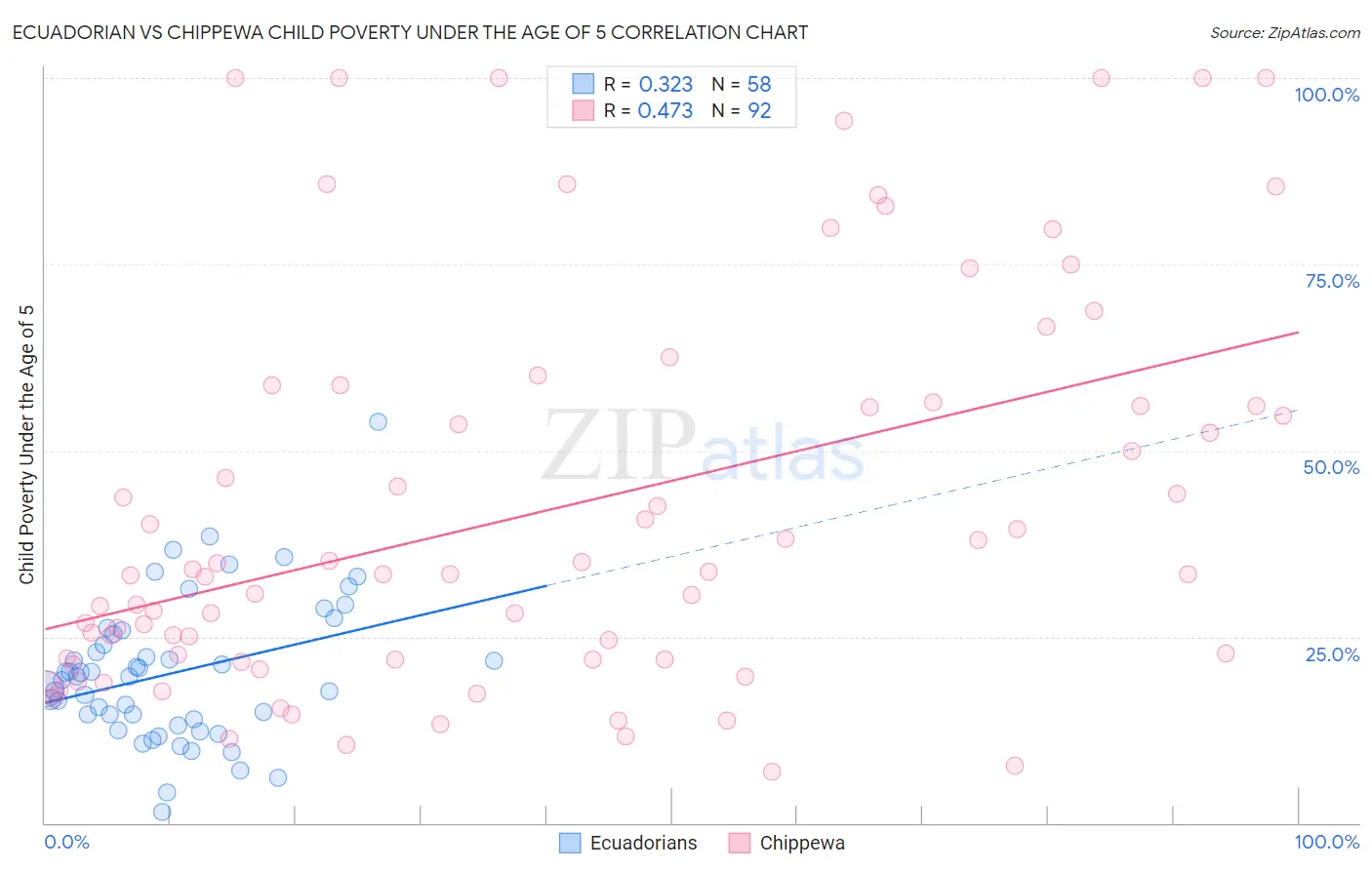Ecuadorian vs Chippewa Child Poverty Under the Age of 5
COMPARE
Ecuadorian
Chippewa
Child Poverty Under the Age of 5
Child Poverty Under the Age of 5 Comparison
Ecuadorians
Chippewa
19.2%
CHILD POVERTY UNDER THE AGE OF 5
1.2/ 100
METRIC RATING
230th/ 347
METRIC RANK
23.4%
CHILD POVERTY UNDER THE AGE OF 5
0.0/ 100
METRIC RATING
319th/ 347
METRIC RANK
Ecuadorian vs Chippewa Child Poverty Under the Age of 5 Correlation Chart
The statistical analysis conducted on geographies consisting of 306,907,692 people shows a mild positive correlation between the proportion of Ecuadorians and poverty level among children under the age of 5 in the United States with a correlation coefficient (R) of 0.323 and weighted average of 19.2%. Similarly, the statistical analysis conducted on geographies consisting of 210,183,643 people shows a moderate positive correlation between the proportion of Chippewa and poverty level among children under the age of 5 in the United States with a correlation coefficient (R) of 0.473 and weighted average of 23.4%, a difference of 21.8%.

Child Poverty Under the Age of 5 Correlation Summary
| Measurement | Ecuadorian | Chippewa |
| Minimum | 1.5% | 6.9% |
| Maximum | 53.9% | 100.0% |
| Range | 52.3% | 93.1% |
| Mean | 20.1% | 42.0% |
| Median | 19.7% | 33.3% |
| Interquartile 25% (IQ1) | 13.9% | 22.0% |
| Interquartile 75% (IQ3) | 25.4% | 56.2% |
| Interquartile Range (IQR) | 11.5% | 34.2% |
| Standard Deviation (Sample) | 9.5% | 26.2% |
| Standard Deviation (Population) | 9.5% | 26.0% |
Similar Demographics by Child Poverty Under the Age of 5
Demographics Similar to Ecuadorians by Child Poverty Under the Age of 5
In terms of child poverty under the age of 5, the demographic groups most similar to Ecuadorians are Ghanaian (19.2%, a difference of 0.040%), Bermudan (19.2%, a difference of 0.050%), Immigrants from Sudan (19.2%, a difference of 0.12%), Cape Verdean (19.1%, a difference of 0.43%), and Immigrants from Eritrea (19.1%, a difference of 0.61%).
| Demographics | Rating | Rank | Child Poverty Under the Age of 5 |
| Cubans | 1.7 /100 | #223 | Tragic 19.1% |
| Nicaraguans | 1.6 /100 | #224 | Tragic 19.1% |
| Nigerians | 1.6 /100 | #225 | Tragic 19.1% |
| Immigrants | Eritrea | 1.5 /100 | #226 | Tragic 19.1% |
| Cape Verdeans | 1.4 /100 | #227 | Tragic 19.1% |
| Immigrants | Sudan | 1.3 /100 | #228 | Tragic 19.2% |
| Ghanaians | 1.2 /100 | #229 | Tragic 19.2% |
| Ecuadorians | 1.2 /100 | #230 | Tragic 19.2% |
| Bermudans | 1.2 /100 | #231 | Tragic 19.2% |
| Trinidadians and Tobagonians | 0.9 /100 | #232 | Tragic 19.3% |
| Sudanese | 0.9 /100 | #233 | Tragic 19.3% |
| Immigrants | Micronesia | 0.9 /100 | #234 | Tragic 19.4% |
| Immigrants | Laos | 0.8 /100 | #235 | Tragic 19.4% |
| Immigrants | Trinidad and Tobago | 0.8 /100 | #236 | Tragic 19.4% |
| Immigrants | Cabo Verde | 0.6 /100 | #237 | Tragic 19.5% |
Demographics Similar to Chippewa by Child Poverty Under the Age of 5
In terms of child poverty under the age of 5, the demographic groups most similar to Chippewa are Choctaw (23.5%, a difference of 0.38%), Immigrants from Honduras (23.5%, a difference of 0.41%), Dutch West Indian (23.3%, a difference of 0.48%), Menominee (23.3%, a difference of 0.58%), and Ute (23.5%, a difference of 0.64%).
| Demographics | Rating | Rank | Child Poverty Under the Age of 5 |
| Hondurans | 0.0 /100 | #312 | Tragic 23.0% |
| Bahamians | 0.0 /100 | #313 | Tragic 23.0% |
| U.S. Virgin Islanders | 0.0 /100 | #314 | Tragic 23.0% |
| Arapaho | 0.0 /100 | #315 | Tragic 23.1% |
| Yakama | 0.0 /100 | #316 | Tragic 23.1% |
| Menominee | 0.0 /100 | #317 | Tragic 23.3% |
| Dutch West Indians | 0.0 /100 | #318 | Tragic 23.3% |
| Chippewa | 0.0 /100 | #319 | Tragic 23.4% |
| Choctaw | 0.0 /100 | #320 | Tragic 23.5% |
| Immigrants | Honduras | 0.0 /100 | #321 | Tragic 23.5% |
| Ute | 0.0 /100 | #322 | Tragic 23.5% |
| Pueblo | 0.0 /100 | #323 | Tragic 23.7% |
| Paiute | 0.0 /100 | #324 | Tragic 23.8% |
| Immigrants | Congo | 0.0 /100 | #325 | Tragic 23.9% |
| Central American Indians | 0.0 /100 | #326 | Tragic 23.9% |